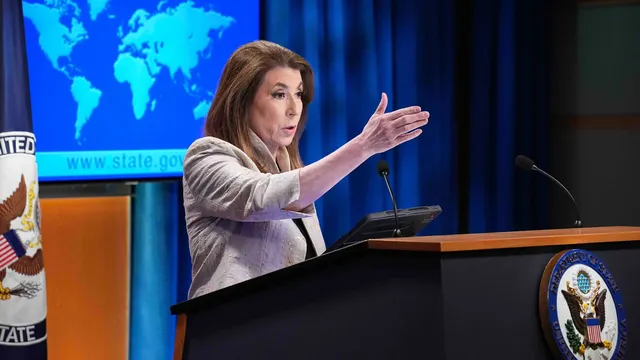
Hamas prolongs suffering by refusing to release hostages and disarm
2025-03-20 19:44- The U.S. State Department attributed around 400 deaths of Gazans to Hamas's actions during airstrikes.
- Tammy Bruce asserted that the ongoing violence is a result of Hamas's refusal to engage in negotiations.
- Growing dissent among Gazans indicates a shift in public opinion against Hamas's governance.
Express your sentiment!
Insights
In Gaza, the ongoing conflict between Hamas and Israel has escalated since October 2023, resulting in significant civilian casualties and destruction. Following a U.S.-brokered ceasefire-hostage deal in January 2025, Hamas had the opportunity to change course by releasing Israeli hostages and ending the conflict. However, Hamas's refusal to release the remaining 59 hostages has worsened the situation, as the group's leadership has shown no intention of relinquishing control or disarming. The collapse of the ceasefire on March 18 highlights the persistent deadlock caused by Hamas's demand for commitments from Israel without any genuine steps towards peace. As airstrikes continue in response to Hamas's actions, the United States has placed blame on the group for the deaths of hundreds of Gazans, stating that Hamas has exploited the situation for their gain. U.S. State Department spokesperson Tammy Bruce emphasized that Hamas's choice to drag their people into the conflict stems from its continued insistence on remaining in power and maintaining the status quo of violence. The dire conditions have led to increased scrutiny from Gazans towards Hamas, with many expressing anger and frustration over the group's actions. Voices of dissent among Palestinians are beginning to rise against Hamas, criticizing the group for prioritizing its control and armed struggle over the well-being of the Gazan people. Analysts report an unprecedented level of contempt directed towards Hamas, indicating a shift in public sentiment. Though the calls for change grow louder within Gaza, the entrenched power of Hamas complicates the prospect of a peaceful resolution. The ongoing military actions and the devastating humanitarian impact felt by civilians raise serious moral questions about the conflict's management. The failure of Hamas to seize this moment to negotiate peace further illustrates the cycles of violence that have plagued the region for decades, leaving many to wonder how much longer the Palestinian people will continue to endure suffering under Hamas's rule.
Contexts
The United States has a long and complex history of involvement in the Israel-Palestine conflict, dating back to the late 1940s when the state of Israel was established. The U.S. was one of the first countries to recognize Israel after its declaration of independence in 1948, amid a backdrop of regional tensions and hostilities resulting from the partition of Palestine. This recognition laid the groundwork for a strong bilateral relationship, characterized by extensive military, economic, and diplomatic support from the U.S. to Israel. This relationship has often been framed around shared democratic values, strategic interests in the Middle East, and a commitment to Israel's security, particularly in light of its experiences in the many conflicts that have erupted since its creation. Moreover, U.S. policymakers have frequently found themselves balancing support for Israel with efforts to address Palestinian aspirations for statehood and human rights, which has proven to be an ongoing challenge. Throughout the decades, significant U.S. initiatives aimed at promoting peace have emerged, such as the Camp David Accords and the Oslo Accords. The U.S. has served as a mediator in various negotiations between Israel and Palestinian leadership, striving to facilitate a two-state solution as a means to resolve the fundamental disputes over territory, governance, and mutual recognition. However, fluctuating American administrations have also influenced the pace and nature of these diplomatic efforts; some periods have seen heightened engagement and optimism, while others have faced stagnation or regression due to escalated violence or political changes. The dynamics of U.S.-Israel relations have further been complicated by internal U.S. politics, public opinion, and advocacy from pro-Israel organizations which have established robust support across various political spectrums. The U.S. has historically provided substantial financial aid to both Israel and the Palestinian Authority, although the nature and extent of this aid have varied. For Israel, military assistance has been particularly significant, with the U.S. providing about $3.8 billion annually in security-related aid since 2016. In contrast, aid to the Palestinians has been less consistent and has often faced budgetary and political hurdles, particularly during periods where U.S. administrations have pursued policies perceived as unfavorable to Palestinian interests. In recent years, there has also been a notable shift in the approach to Palestinian aid, with increased scrutiny and conditionality tied to governance and security reforms. As of 2025, the ongoing conflict continues to manifest through renewed violence, settlements expansions, and regional geopolitical shifts that impact U.S. involvement. The U.S.'s role as a mediator has faced skepticism from various stakeholders, with calls for a more balanced approach that equally considers the rights and aspirations of the Palestinian people. Controversies regarding U.S. engagement, such as the recognition of Jerusalem as Israel’s capital in 2017 and shifting approaches toward international bodies like the United Nations, have led to significant debate within the U.S. as well as among its allies. While American leaders remain committed to Israel's security, navigating the complex realities on the ground and fostering a sustainable peace will require a nuanced understanding of the historical context and current dynamics of the Israel-Palestine conflict.